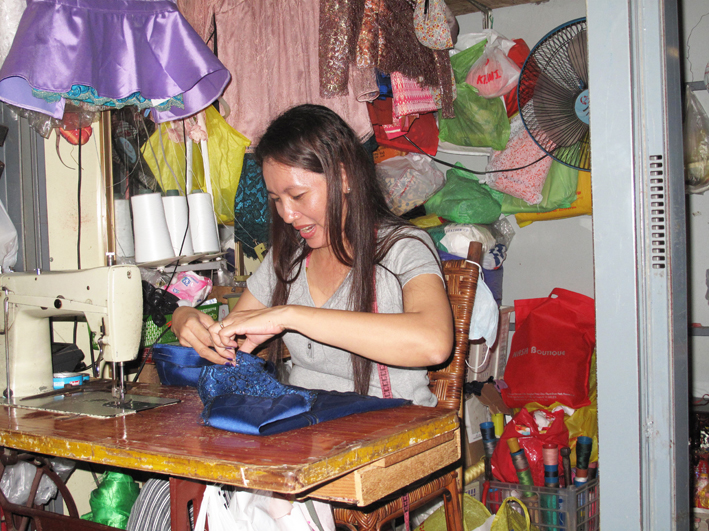Moving Up-Market From Off-The-Rack in Cambodia

By Jody Hanson
South East Asia has some of the most beautiful natural fabrics in the world – silk, linen and cotton – and the people to whip up the clothes for you. When it comes to getting a new wardrobe, the basic problem is that most people don’t think it through. Instead they wander into some shop in Bangkok that offers packages and end up with things they don’t like and will never wear.
Like any other successful endeavor, getting the outfits you want is all in the planning.
By way of terms clarification, tailors are men and handle the heavier materials, like suits. Women are seamstresses and work with lighter fabrics.
Figure out what you want
Think about your style and the image you want to reflect. If you are a backpacker type of chick, you likely don’t want a silk ball gown for an opening. If you are a corporate-whore, however, you might want to get some good-quality suits made to impress the boys and girls back in the boardroom.
Get it copied
Have a favorite dress that you will wear forever and ever? Stick it in your suitcase and get it copied in five colors.
Good seamstresses can make it so close to the original that you may have difficulty telling them apart.
Take along a photo
Rip a page out of Vogue, Elle or Harper’s Bazaar and take it with you. Rather than trying to sketch it out, show the seamstress exactly what it is you want.
Check out the material
This is where it gets tricky if you don’t know anything about fabric. See if you can get some advice from the tailor or someone who knows what sort of material is required for what sort of garment. Raw silk is too stiff for a little camisole, but the light version is perfect.
A Shopping Trip to Central Market
Now that I live in Phnom Penh – the capital of Cambodia – getting clothes made is relatively simple. Remember that you have to bargain as only total-tourists pay the asking price. That said, the market people know me so now they give me their last price first.
Raw hand-woven silk – made in the provinces so it helps support rural families – costs $8 a meter. Lighter – but still hand-woven – comes in at the same price. The machine made version is about $3.
Linen has different grades and weights, but starts at about $3 a meter. Expect to pay $5 for decent cotton.
The tailor or seamstress will tell you how many meters you need to buy. Do a rough calculation yourself, as sometimes s/he might tack on some extra fabric. If you want to check, take her/his tape measure and pretend you are figuring it out. The fabric required may come down.
Find a seamstress
The best way to get a good tailor/seamstress is through personal recommendations. I wrote a piece on silk over a year ago and got to know Lake, a young English-speaking Cambodia who is now studying in Sydney. Her family runs a silk stall.
When I asked her who knew how to sew she said, “You can try Tek Sipha,” and introduced me. If you happen to be in the Kingdom and at Central Market, her stall is number H3 071.
What to look for
Before you leave a deposit for five shirts and six pair of shorts, look at the work she does. Are the seams straight? Do the button-holes have jagged edges? Are the zippers sewn in evenly? Are there bulges in the sides of the seams?
Negotiate a Price
Make sure you agree on a price before you come back to a nasty surprise of $75 for a pair of trousers.
It is difficult to give an estimation as prices vary depending on the seamstress and how much detail you want. For simple trousers, Tek Sipha charges $7. A plain dress without a lining will come in at $12. A friend had four nursing uniforms – a top and pants – made for $13 each.
In summary
With the wide array of fabrics, and the reasonable prices, go ahead and make your own fashion statement that isn’t available at the local western boutique.
Jody Hanson is an insufferable travel junkie who has visit 107 countries – 67 on her own – lived in nine and holds passports in three. She has visited all the countries in North, Central and South America except for Venezuela, Guyana, Surname and French Guinea. She wrote this article on behalf of Tucan Travel who offer adventure travel to Cambodia and all over Southeast Asia.
Related Posts
Comments
By accepting you will be accessing a service provided by a third-party external to https://style-review.com/

